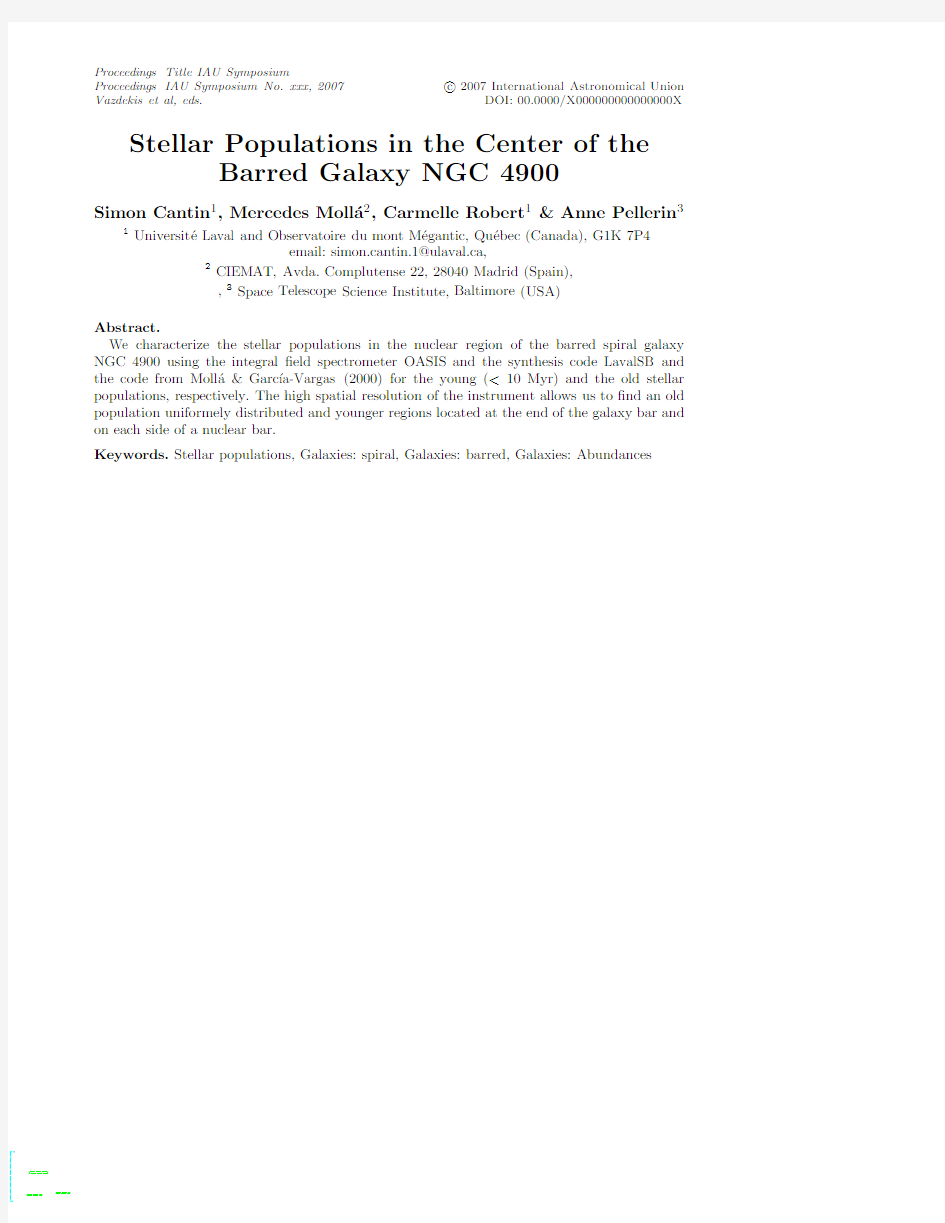

a r
X
i
v
:a
s t
r o
-
p
h
/
7
1
8
6
2v
1
3
J
a
n
2
7
Proceedings Title IAU Symposium Proceedings IAU Symposium No.xxx,2007Vazdekis et al,eds.c 2007International Astronomical Union DOI:00.0000/X000000000000000X Stellar Populations in the Center of the Barred Galaxy NGC 4900Simon Cantin 1,Mercedes Moll′a 2,Carmelle Robert 1&Anne Pellerin 31Universit′e Laval and Observatoire du mont M′e gantic,Qu′e bec (Canada),G1K 7P4email:simon.cantin.1@ulaval.ca,2CIEMAT,https://www.doczj.com/doc/7813409725.html,plutense 22,28040Madrid (Spain),,3Space Telescope Science Institute,Baltimore (USA)Abstract.We characterize the stellar populations in the nuclear region of the barred spiral galaxy NGC 4900using the integral ?eld spectrometer OASIS and the synthesis code LavalSB and the code from Moll′a &Garc ′?a-Vargas (2000)for the young (<10Myr)and the old stellar populations,respectively.The high spatial resolution of the instrument allows us to ?nd an old population uniformely distributed and younger regions located at the end of the galaxy bar and on each side of a nuclear bar.Keywords.Stellar populations,Galaxies:spiral,Galaxies:barred,Galaxies:Abundances
120Cantin et al.
Figure1.Maps of the averaged age and metallicity for the old stellar populations in top panels and for the younger ones at the bottom.Average metallicity[Fe/H]and12+log(O/H)are at the left.Corresponding log(age)are to the right.North is up and East is at the left.
From the absorption line equivalent widths for Mg2,Fe5270,Fe5335,and Hβand using the code from Moll′a&Garc′?a-Vargas(2000),it was possible to obtain the averaged age and metallicity[Fe/H]maps for the old stellar populations(see Fig.1).The?rst one reveals a rather uniform population of at least~100Myr(orange color)with a younger region of~10Myr to the SE.The metallicity[Fe/H]is near solar and rather uniform. From the equivalent width of the emission lines Hαand Hβand using the code LavalSB (Dionne&Robert2006)we estimate the age and the oxygen abundance for the young stellar populations,too.The age map shows an ellongated region between5and7Myr to the SE and a region of8Myr in the NW corner.These young regions are at the end of the galactic bar on each side of a nuclear bar seen in the extinction map(not shown here).The gas abundance is oversolar(12+log(O/H)?8.8)with a higher value for the young SE region.
In summary,we?nd three episodes of star formation.The?rst one occurred a few100 Myr ago involving uniformely the central region.At the NW end of the bar,a second episode of star formation took place8Myr ago.The third one occurred between5or6 Myr on the other side of the nucleus.Abundance and younger star forming regions seem to imply an in?ow of high metallicity gas or recurent star formation.
References
Combes,F.,Garc′?a-Burillo,S.Boone,F.et al.2004,A&A,414,857
Dionne,D.,&Robert,C.2006,ApJ,641,252
Moll′a,M.,&Garc′?a-Vargas,M.L.2000,A&A,359,18
Mu?n oz-Tu?n′o n,C.,Caon,N.,&Aguerri,J.A.L.2004,AJ,127,58
Schinnerer,E.,Eckart,A.,Tacconi,L.J.,Genzel,R.,&Downes,D.2000,ApJ,533,850 Shlosman,I.,Frank,J.,&Begelman,M.C.1989,Nature,338,45